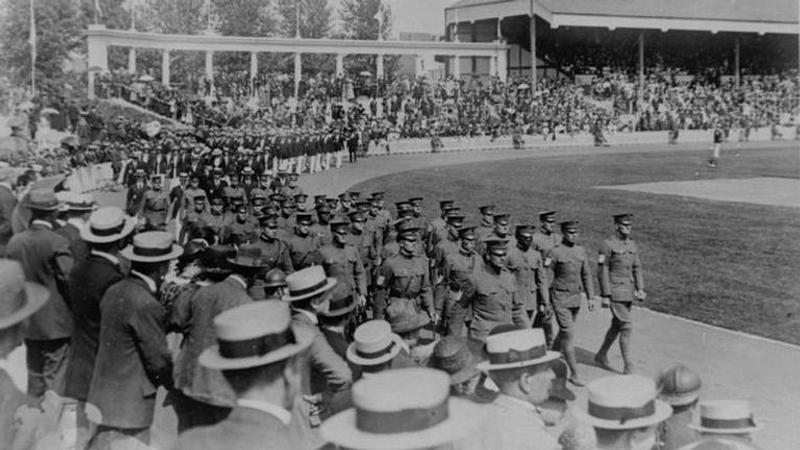Published 13:36 IST, July 28th 2020
Antwerp 1920 Olympics haunted by war and flu pandemic
When the Olympic Games resumed after World War I, the event was not designed to escape the horrors of war. The Anwtwerp Games were used to remember.

When the Olympic Games resumed after World War I, the event was not designed to escape the horrors of war. The Anwtwerp Games were used to remember.
Belgium hosted after being a battleground two years before. Many athletes were veterans. The opening ceremony celebrated military might as much as peace.
On their way into Antwerp's Beerschot Stadium attendees walked past a statue of a Belgian soldier throwing a grenade, then heard artillery salutes punctuate the ceremony. The Belgian fencer who took the Olympic oath to compete “in a spirit of chivalry, for the honor of our country and for the glory of sport” was Victor Boin, an air force pilot, flanked by two soldiers.
Many Olympians from the last games in 1912 had been killed or wounded during the war, when amateur gentleman athletes flocked to serve as military officers. Yet more athletes were killed by the Spanish Flu pandemic that ravaged the world soon after.
In Antwerp a new generation of athletes came to the fore. The Olympics were still very much centered on white, male athletes from privileged backgrounds, but times were slowly changing.
Female athletes overcame social disapproval and resistance from some Olympic officials to compete, and Japan won the first medals for an independent Asian nation.
LENGLEN CHUNK
Of the approximately 2,600 athletes, only about 60 were women. But French tennis player Suzanne Lenglen transcended the Olympics as an international star.
Nicknamed “La Divine,” she was a national hero and a household name around the world. The women's trophy at the French Open and the second-largest court both bear her name.
In Antwerp, Lenglen didn't drop a game in her first three singles matches and didn't drop a set all tournament in her run to the gold medal. She added gold in the mixed doubles and bronze in the women's doubles.
Illness meant Lenglen couldn't defend her title on home soil at the next Olympics in Paris in 1924, the last time the sport would be on the program until 1988.
Tennis in Antwerp was also a breakthrough for diversity, as Japan won its first medals. Ichiya Kumagae won silver in men's singles and added a doubles silver with Seiichiro Kashio. No independent Asian country had won a medal before, though India had won two silvers in 1900 under British rule.
ICELAND ON ICE
The Winter Olympics were yet to be invented, so ice hockey joined the Games in a program otherwise packed with summer sports. Canada won the inaugural men's hockey gold medal, but it was a Canadian team with a twist.
Team Canada was actually the Winnipeg Falcons, an amateur team set up by Icelandic immigrants. Their name was taken from a falcon on Iceland's old coat of arms at a time when it was still part of Denmark.
With future two-time Stanley Cup winner Frank Fredrickson as captain, the Falcons demolished the opposition in Antwerp, beating Czechoslovakia 15-0, the United States 2-0. The Falcons' shutout run ended in the gold-medal game against Sweden but they still won 12-1.
Hockey and figure skating were held a full four months before the other sports in an Antwerp rink called the Ice Palace. The International Olympic Committee drew on that experience when it created an “international winter sports week” in Chamonix, France, in 1924. That was later officially recognized as the first Winter Olympics.
FLYING FINNS
These days Finland is best known for its hockey players and cross-country skiers, but in 1920 it was the undisputed distance-running superpower.
Hannes Kolehmainen had won three gold medals in 1912 and cemented his place in history by winning the 1920 marathon in world record time despite heavy rain making the course muddy. Antwerp was the year when Kolehmainen metaphorically passed the torch to another all-time great, his fellow Finn Paavo Nurmi. Aged 23, Nurmi won three gold medals in Antwerp and would later win six more.
When Finland held the Olympics in 1952, Nurmi passed the torch back — literally. Nurmi carried the Olympic torch into the stadium in Helsinki during the opening ceremony and handed it over for Kolehmainen to light the flame.
ALONE ON THE WATER
Most Olympic champions need training, determination and luck to win the gold. In 1920 it was enough just to turn up.
Norwegian sailors won five gold medals in Antwerp completely unopposed after no other crews entered their events. They still had to sail out alone on the water, round the buoys and cross the line without sinking to earn a gold medal.
Out of 13 different sailing competitions, only one featured more than three boats, meaning almost everyone went home with a medal. One event was a shootout between two Dutch crews, who were allowed to finish off the contest back home in the Netherlands.
Updated 13:37 IST, July 28th 2020




